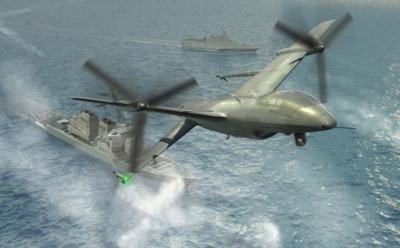Thu, Mar 26, 2015
System Would Enable Small Ships To Host Their Own Unmanned Air Systems
DARPA has awarded prime contracts for Phase 2 of Tern, a joint program between DARPA and the U.S. Navy’s Office of Naval Research (ONR). The goal of Tern is to give forward-deployed small ships the ability to serve as mobile launch and recovery sites for medium-altitude, long-endurance unmanned aerial systems (UAS).

These systems could provide long-range intelligence, surveillance and reconnaissance (ISR) and other capabilities over greater distances and time periods than is possible with current assets, including manned and unmanned helicopters. Further, a capacity to launch and retrieve aircraft on small ships would reduce the need for ground-based airstrips, which require significant dedicated infrastructure and resources. The two prime contractors selected by DARPA are AeroVironment, Inc., and Northrop Grumman Corp.
“To offer the equivalent of land-based UAS capabilities from small-deck ships, our Phase 2 performers are each designing a new unmanned air system intended to enable two previously unavailable capabilities: one, the ability for a UAS to take off and land from very confined spaces in elevated sea states and two, the ability for such a UAS to transition to efficient long-duration cruise missions,” said Dan Patt, DARPA program manager. “Tern’s goal is to develop breakthrough technologies that the Navy could realistically integrate into the future fleet and make it much easier, quicker and less expensive for the Defense Department to deploy persistent ISR and strike capabilities almost anywhere in the world.”
The first two phases of the Tern program focus on preliminary design and risk reduction. In Phase 3, one performer will be selected to build a full-scale demonstrator Tern system for initial ground-based testing. That testing would lead to a full-scale, at-sea demonstration of a prototype UAS on an at-sea platform with deck size similar to that of a destroyer or other surface combat vessel.
(DARPA artist's concept)
More News
Airport Marking Aids Markings used on runway and taxiway surfaces to identify a specific runway, a runway threshold, a centerline, a hold line, etc. A runway should be marked in ac>[...]
"It is extremely difficult, if not impossible, for manned aircraft to see a drone while conducting crop-enhancing and other aerial applications at low altitudes and high speeds. We>[...]
Aero Linx: The Skyhawk Association The Skyhawk Association is a non-profit organization founded by former Skyhawk Pilots which is open to anyone with an affinity for the A-4 Skyhaw>[...]
“The T-54A benefits from an active Beechcraft King Air assembly line in Wichita, Kansas, where all required METS avionics and interior modifications are installed on the line>[...]
Aero Linx: Aerostar Owners Association The Association offers the Aerostar Owner a unique opportunity to tap an invaluable source of information concerning the care and feeding of >[...]
 ANN's Daily Aero-Term (04.28.24): Airport Marking Aids
ANN's Daily Aero-Term (04.28.24): Airport Marking Aids Aero-News: Quote of the Day (04.28.24)
Aero-News: Quote of the Day (04.28.24) ANN's Daily Aero-Linx (04.28.24)
ANN's Daily Aero-Linx (04.28.24) Aero-News: Quote of the Day (04.29.24)
Aero-News: Quote of the Day (04.29.24) ANN's Daily Aero-Linx (04.29.24)
ANN's Daily Aero-Linx (04.29.24)



